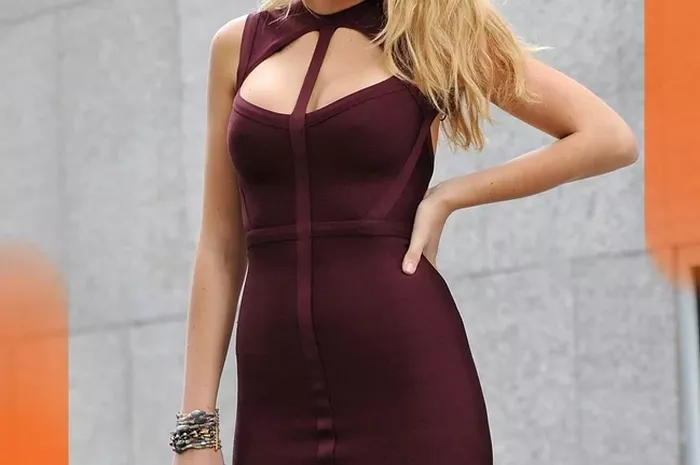In 2010, a typical night out might have included pastel blue dip-dyed hair, borrowed baby pink bandage dresses, and layers of mascara thick enough to rival false lashes. The atmosphere was carefree, albeit restrictive—both literally and figuratively. The bandage dress, so tight it prevented proper movement, was more of a costume than an outfit, a visual signal of fitting into a specific mold. It was a time of glossy surfaces and hidden discomforts, a moment of youth where aesthetics trumped ease.
Today, bandage dresses are making a comeback. Although associated with a seemingly distant fashion era, they are stepping back into the spotlight. This resurgence isn’t just another trend revival; it carries deeper implications. Originally designed by Hervé Léger in the mid-1980s and introduced on the runway in 1992, the dress became a cultural phenomenon in the 2000s. Worn by figures like Rihanna, Victoria Beckham, Kim Kardashian, and Blair Waldorf from Gossip Girl, it became a staple in red carpet and nightlife fashion. Now, with brands like House of CB promoting the hashtag #BANDAGEISBACK, the debate around its return is heating up. While some embrace the aesthetic shift away from cottagecore and milkmaid looks, others express strong discomfort, associating the bandage dress with body restriction, outdated beauty standards, and physical unease.
Criticism of the bandage dress isn’t rooted in aesthetics alone. For many, it evokes the pressures of diet culture. The dress, with its skin-tight fabric and unforgiving silhouette, often dictated who could wear it and who could not. At the time, social messaging suggested it was only for those who had no visible stomach but just enough curve to create the illusion of hourglass perfection. It reinforced a harmful ideal: to be both slim and shapely, to ‘suck in’ while appearing naturally contoured. This created an impossible standard for most, despite the claim that the dress suited “all body types.”
In reality, bandage dresses were rarely available in sizes above 12, and representation was notably lacking. Plus-size celebrities were practically nonexistent in these designs. Among friend groups, these dresses were shared, rotated, and worshipped like relics of conformity, fitting only the narrowly defined ideal body. Skipping meals and enduring hours of discomfort were part of the ritual, a silent acceptance of the dress’s demands. After nights of partying, there was almost a sense of liberation in taking the dress off—finally able to breathe, eat, and feel human again.
What is troubling about the bandage dress’s return is not merely its style, but its timing. Its resurgence coincides with a renewed societal obsession with thinness. Platforms like TikTok have seen the rise of “SkinnyTok,” though the hashtag is now banned. Semaglutide injections are being used off-label to shrink bodies, and public figures once celebrated for size diversity are becoming noticeably slimmer. All this is happening against the backdrop of rising political conservatism, the rollback of rights for women and marginalized communities, and an alarming uptick in online fatphobia.
Feminist philosopher Kate Manne recently explored this phenomenon in her Substack Why Are Celebrities’ Bodies Shrinking?. She draws a parallel between shrinking female bodies and the rise of authoritarian politics, suggesting that the ideal woman today is one who embodies conventional femininity—thin, white, frail, and seemingly in need of male protection. Figures like Melania Trump and Hannah Neeleman of Ballerina Farms reflect this image: women whose physical appearance symbolizes wealth, health, and submission. These ideals are not random; they signal a larger societal narrative of control and regression.
So, while the return of the bandage dress may look like a harmless flashback, it represents more than just a revival of 2010s fashion. It symbolizes the resurfacing of body expectations rooted in control, restriction, and exclusion. In a moment when women’s rights and autonomy are increasingly under pressure, the return of such a physically constrictive garment cannot be separated from broader cultural messages. Bandage dresses, it seems, are not just garments—they are political statements.
In the end, fashion is never just about clothes. It’s about power, visibility, and autonomy. The return of the bandage dress might be pitched as nostalgic, but its message is current and deeply coded. As society faces renewed pressure to shrink, to conform, and to disappear into outdated ideals, the bandage dress feels like a uniform for surrender. And in this context, choosing to wear one—or not—is about more than just taste. It’s a reflection of the world we are either accepting or resisting.
Related Topics
- Women Who Transformed Fashion: Challenging Norms and Shaping the Industry
- Shinseong Trading Makes Second Delisting Attempt Amid Investor Scrutiny
- 8 Affordable Fashion Brands in Dubai That Don’t Compromise on Style

